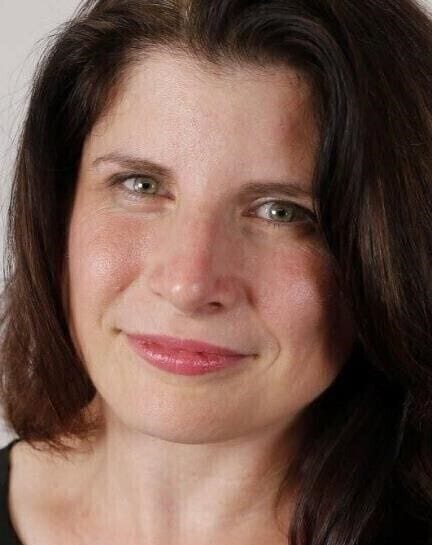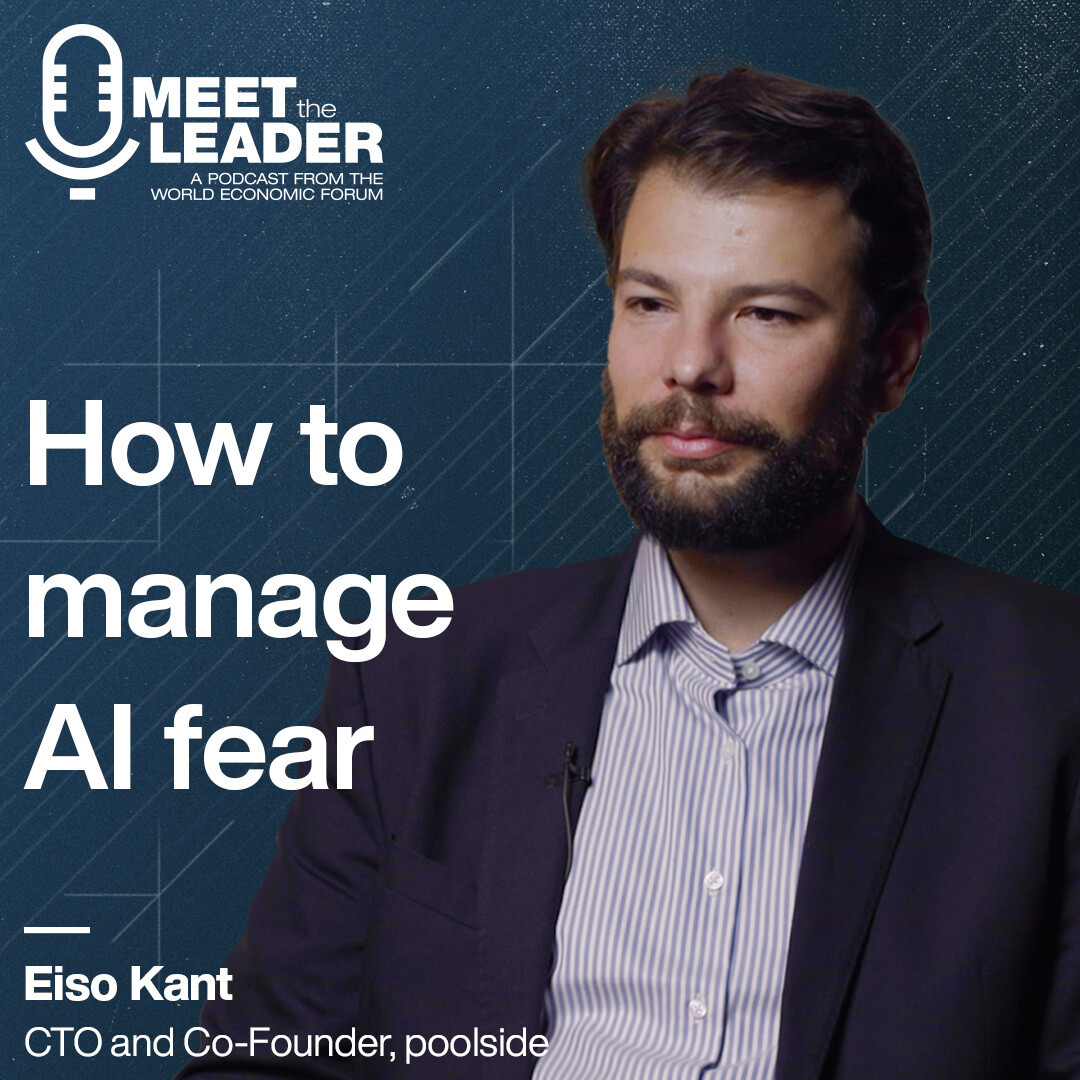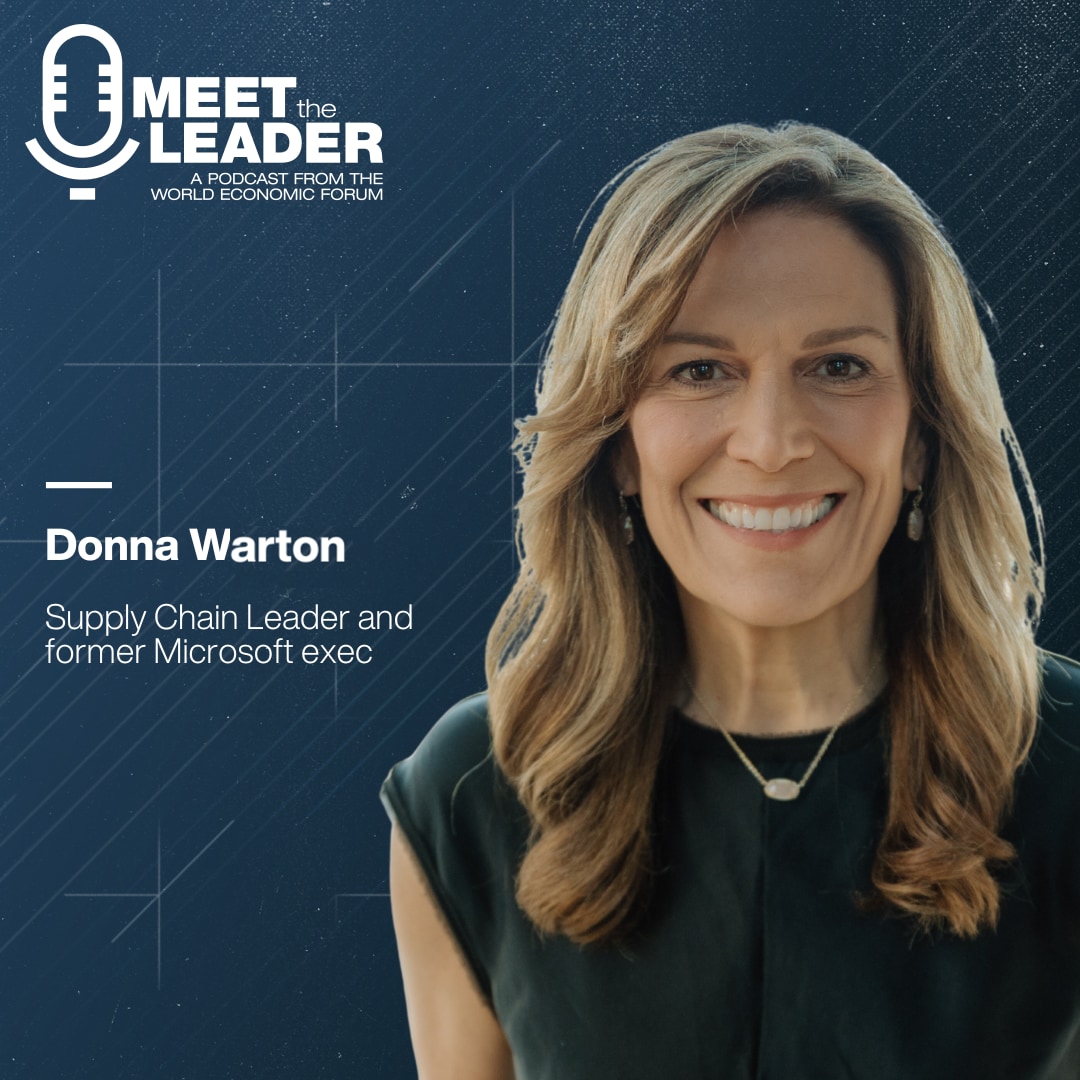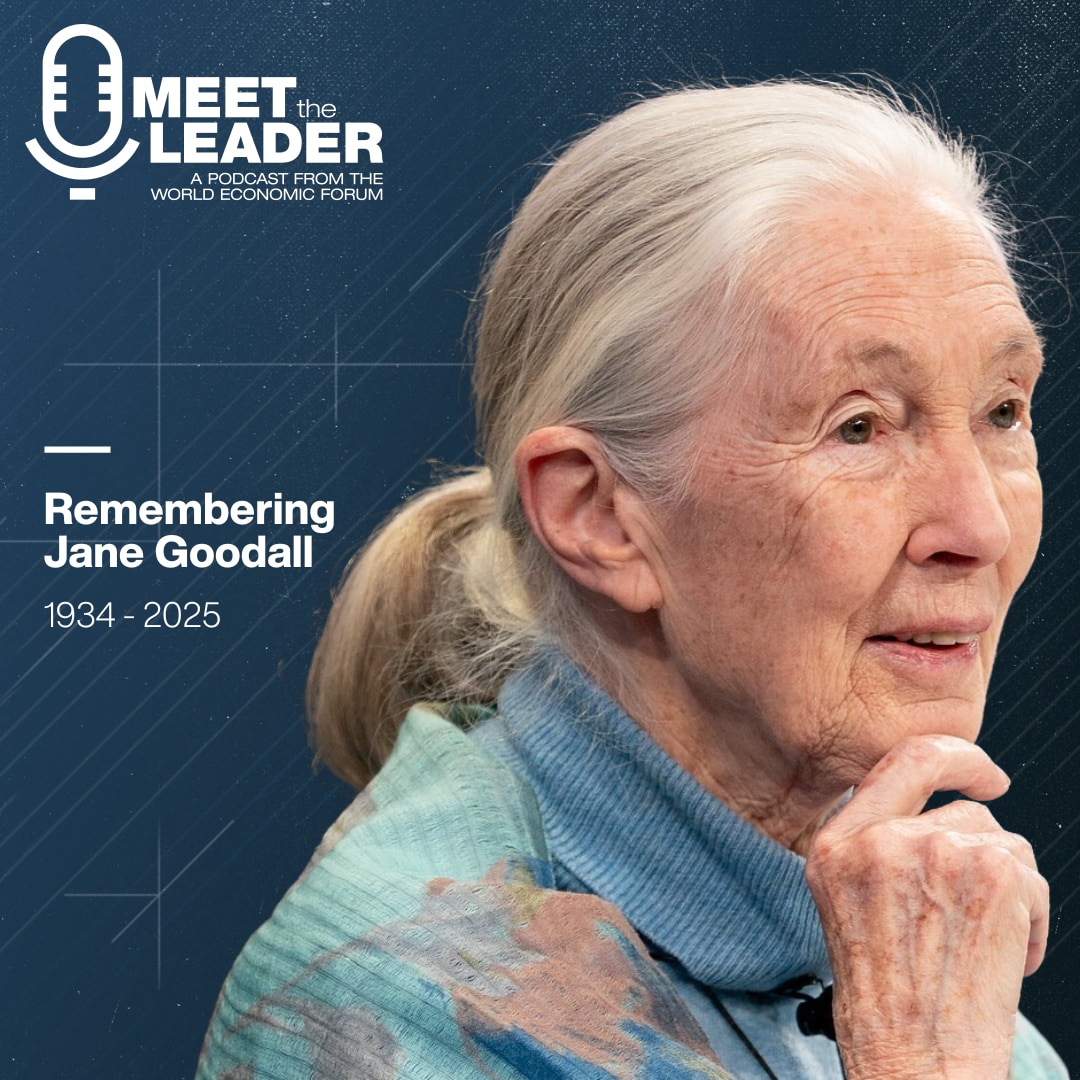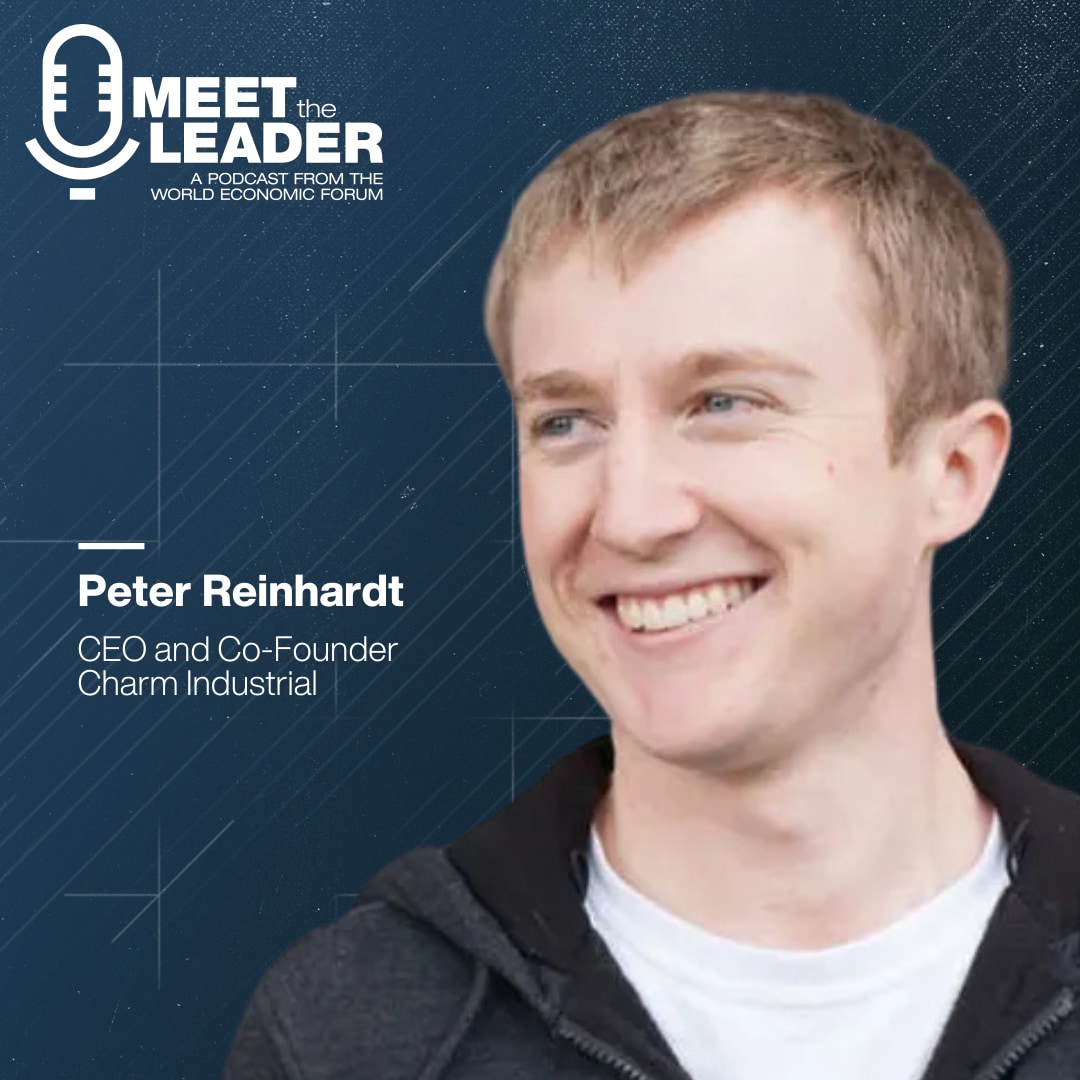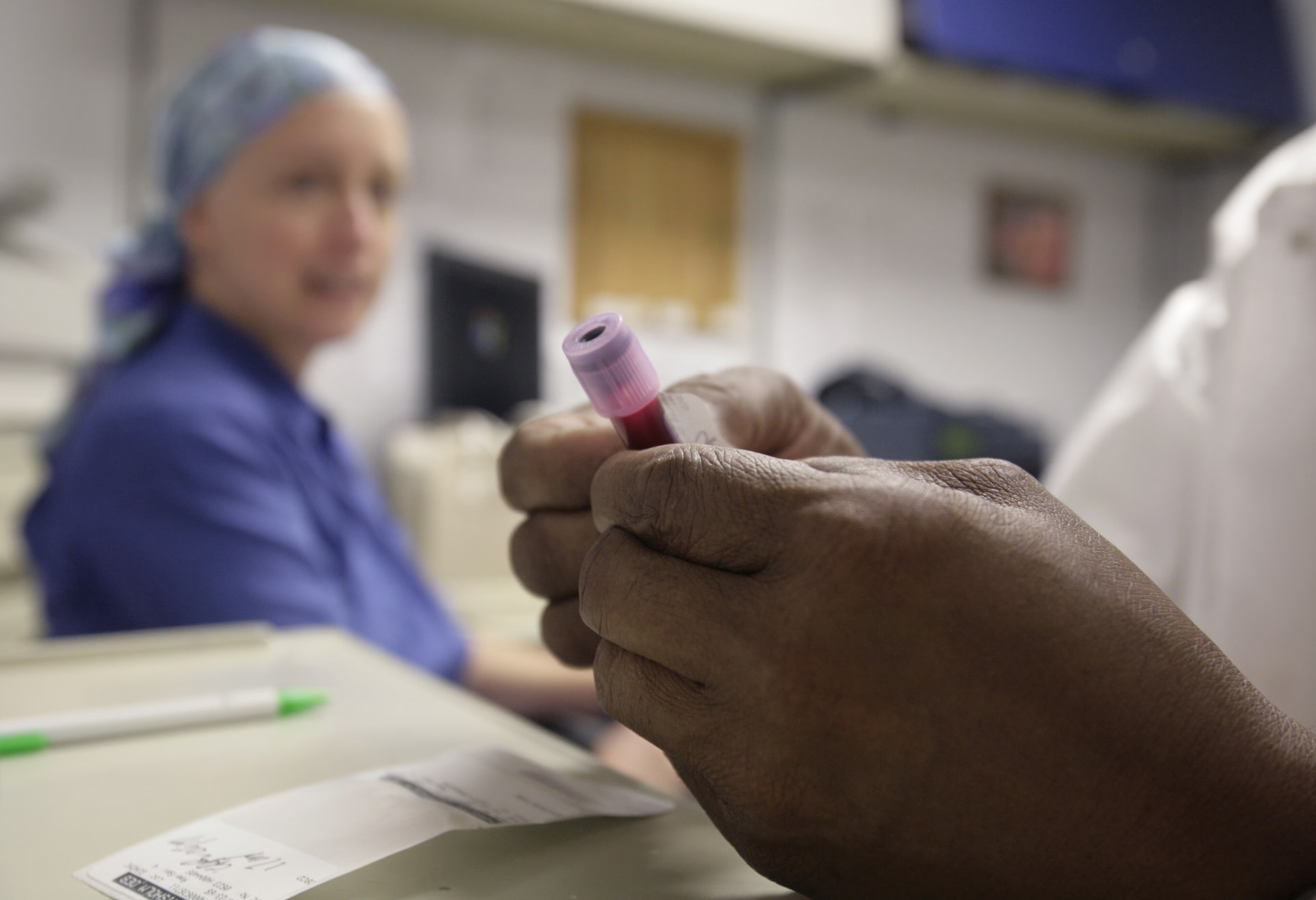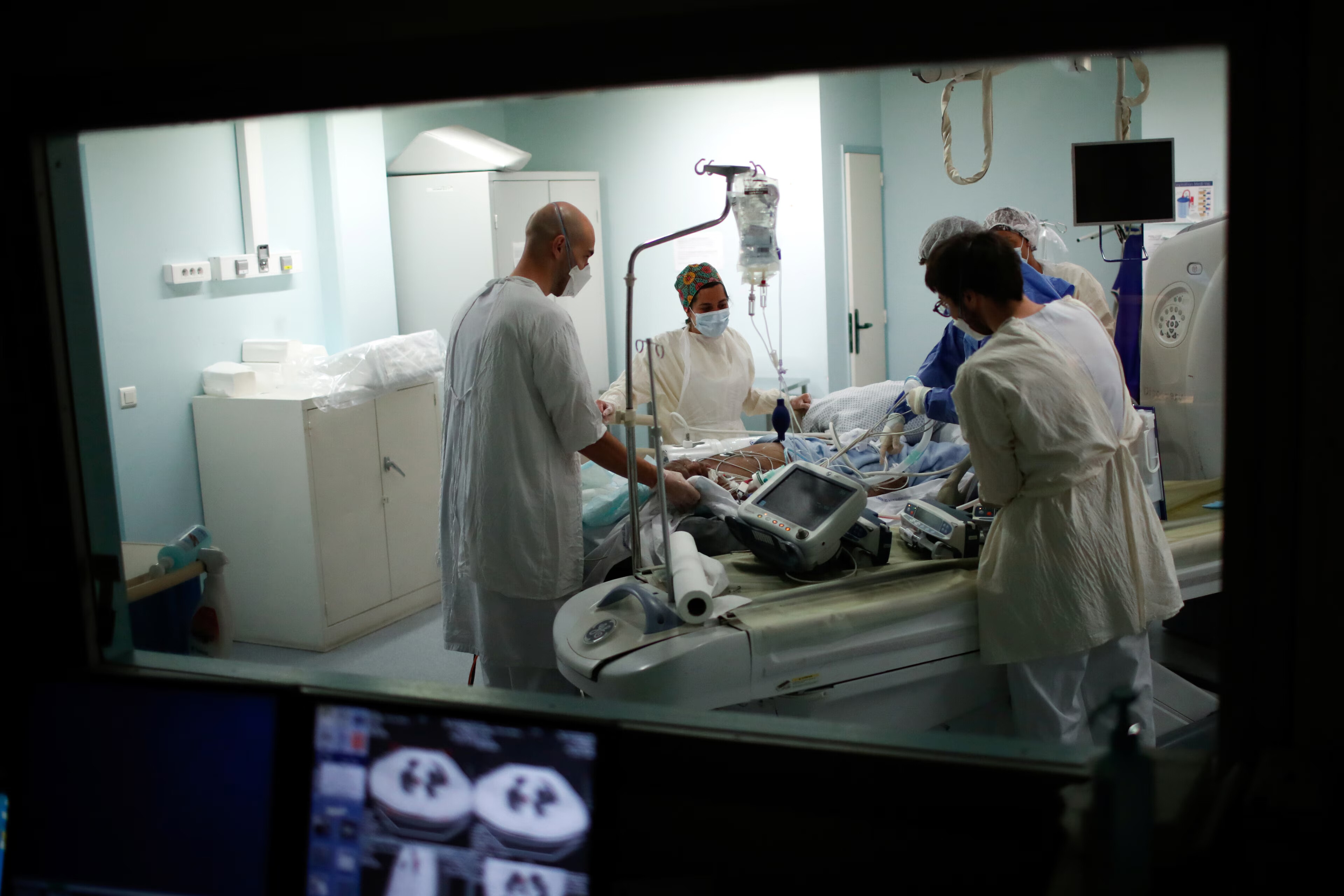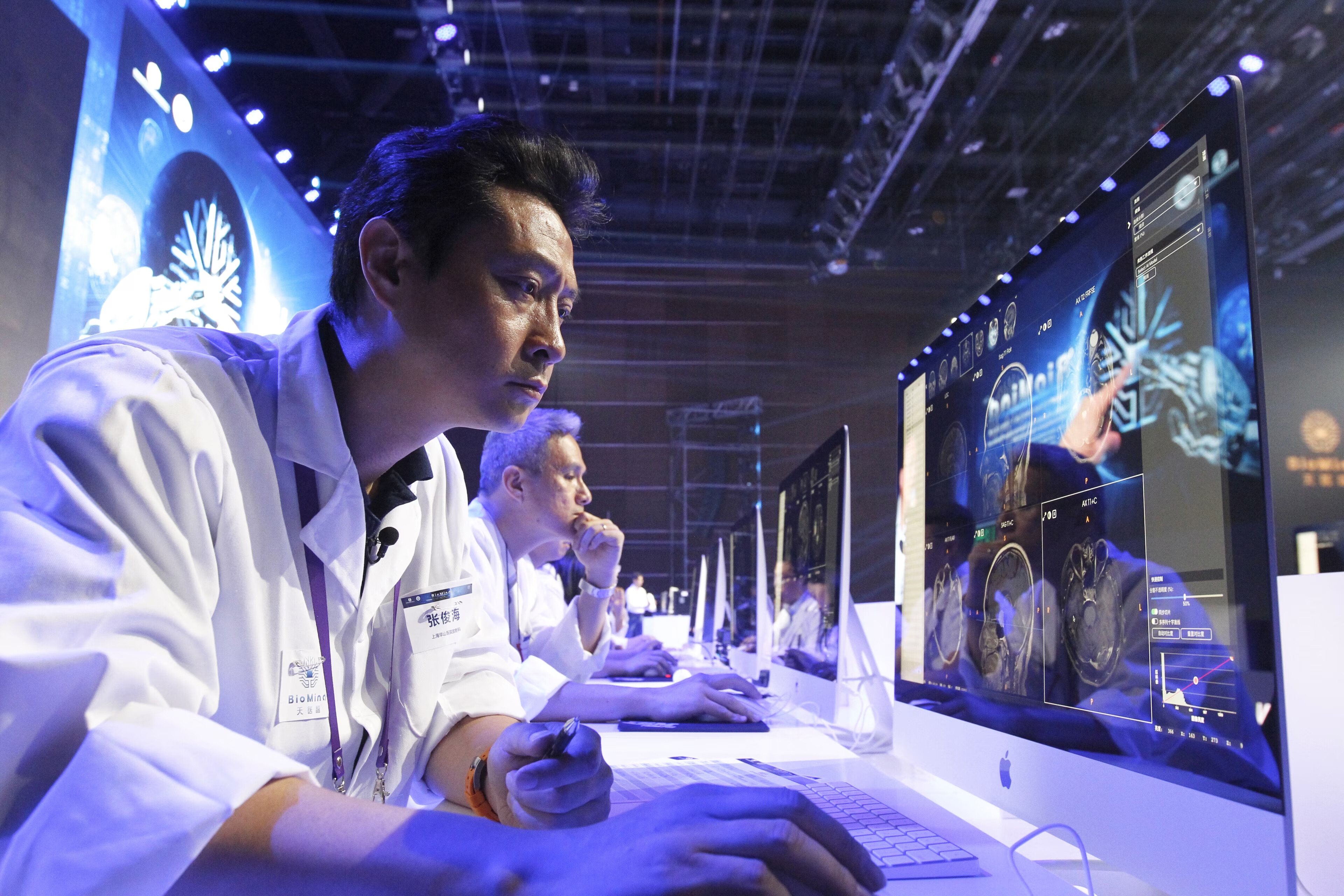How one global health leader prepares teams for the unexpected: Gavi CEO
How does the CEO of an organization brought in to help respond to fast-moving health crises like Mpox and other infectious diseases plan for the unexpected? Sania Nishtar heads up Gavi - The Vaccine Alliance, an organization that has helped vaccinate over one billion children in the world's poorest countries and prevent more than 18 million deaths worldwide. Sania talks to us about the planning, mindsets, technologies and scenario planning her team uses to be ready for any emergency. She explains the importance of securing ‘crystal clarity’ in advance for what its expected to deliver and how that helps the organization prepare for a range of circumstances and efficiently coordinate with governments and other global organizations when time is of the essence. This organization was launched at Davos 25 years ago and she shares what what’s needed for global health security and strengthened public health systems now and in months and years ahead.
This interview was recorded in January 2025 at the Annual Meeting in Davos, Switzerland
ポッドキャスト・トランスクリプト
Sania Nishtar, Gavi: When I was a new CEO, I was very conscious we have absolute clarity on what I am expected to deliver, when and in what circumstances. So I created several scenarios as a wargaming exercise. If if there's a health emergency, how is Gavi going to mobilize?
And then when Mpox struck, we we had crystal clarity on what needed to be done. Emergencies do not give you the latitude to plan at that time. You have to be prepared.
And I think it's very important that we that we collaborate well during an emergency. There is no room for competitive behaviors within this space. There's no room for egos. We must support each other and make sure that the global global response to support countries is adequate, is timely, it's well-coordinated.
Where you are born should not determine whether you live or die.
”
Linda Lacina, Meet The Leader: Welcome to Meet the Leader. I am Linda Lacina and I am very excited to welcome Dr Sania Nishtar here to the Meet the Leaders studio. She is the CEO of the Gavi Alliance, and that is an incredible organization that has helped vaccinate over one billion children in the world's poorest countries. She is here to talk to us about global health security. She's also going to help us understand how leaders can plan for the unexpected. Gavi turns 25 this year. She's going to tell us what they've done so far, and also tell us what they have ahead. How are you, Sania.
Sania Nishtar, Gavi: I'm very well, Thank you, Linda, for having me in your studio.
Linda Lacina, Meet The Leader: We are very excited. So I'm going to get started with giving people a little bit more information on Gavi, for folks who may not be as familiar. Can you give them sort of the broad strokes, what's important for them to know?
Sania Nishtar, Gavi: So where you are born should not determine whether you live or die. And Gavi, as an international public-private partnership, has played a pivotal role, with respect to that statement, because since its creation here in Davos 25 years ago, it has provided access to vaccination for low-income countries, for children in low-income countries.
It has vaccinated over a billion children in the process. It has saved close to 19 million lives, and it has accrued over $200 billion of economic benefits to the society. So that's one of the core mandates of Gavi, to provide access to vaccination for low-income countries.
Gavi also plays a very pivotal role in global health security. During the COVID-19 pandemic, for instance, it provided two billion doses of vaccines to 146 countries in the fastest and the shortest time possible, averting around 7 million deaths. And half of the portfolio of vaccines that Gavi has are deeply relevant to climate-sensitive diseases and to antimicrobial resistance.
And Gavi is a very innovative organization. It flows vaccine bonds, it mobilizes money for this very important mission. It is also one of, I would say, one of the only entities in the global health space that actively engages with the private sector. It shapes the market. It really helps to bring down the cost of vaccines.
Gavi is also a very unique organization in the global health landscape, because sustainability is hardwired in its model. When we start introducing vaccines in a country, countries go big, alongside Gavi, and as their economic situation improves, their share of co-pay increases and ultimately they graduate out of our support. So, countries as large as India, which were initially in the Gavi fold, which were initially countries that were supported by Gavi, are today paying for their vaccines totally on their own. They've institutionalized vaccines into their wholesale health delivery agenda.
And Gavi has done remarkably well in terms of graduating 19 countries from the cohort of 78 that were initially Gavi-implementing countries.
So, there is hardly a global health entity which delivers results, you know, in terms of lives saved, in terms of economic benefits, and does it at a very low cost – less than 3% of the cost – and is very innovative in terms of engaging stakeholders and bringing a range of benefits to the society at large.
Linda Lacina, Meet The Leader: You talked about global health security, let's talk a little bit about that, just for broad stroke. How is the world doing when it comes to global health security? If you were going to give a grade, what would you give?
Sania Nishtar, Gavi: So, over the last over the last few decades, we have seen a number of emerging, and reemerging, infections. And of course, COVID-19 is still in our memories. Over the last decades, the world has seen an increasing onslaught of emerging and re-emerging infections. But, of course, each time we've learned and we've made ourselves better.
Nothing is perfect, of course, but during COVID-19, Gavi was able to provide two billion doses of vaccines to 146 countries, in the shortest possible time. So, we have gotten better with our response, but we need to do a lot better.
And when it comes to preventing, and tackling and managing global public health emergencies, there are a range of institutional actors within the global health space that have responsibilities. There are regional entities that are increasingly becoming more important. And then, of course, at the heart of it, is the response that has to be led by countries.
I was previously the Minister of Social Protection in Pakistan, just before joining as the CEO of Gavi. And during the COVID-19 response, I was one of the three-member committee of the cabinet that looked at the response more holistically in terms of access to vaccines. And I can tell you that it was a whole of government effort. This was not a health effort. This was not something small that was led out of the Health Ministry. It was a whole of government response.
When it comes to preventing, and tackling and managing global public health emergencies, there are a range of institutional actors within the global health space that have responsibilities
”So, when it comes to preparedness against health emergencies, when it comes to resilience against emerging and reemerging infections, we must not forget that it is a number of different entities within the global health landscape, of which Gavi is one and WHO [World Health Organization] is the overall steward. But it is also the response at the country level, a whole of government response at the country level, with regional entities playing a part. That has to be part of the equation.
Since we are talking about, and your question was about how we are doing, I think I must also mention that we have really learned from lessons, and many of us as stakeholders, as global stakeholders in the response, have really stepped up by putting in institutional mechanisms, and structures, and systems in place.
Let me give you Gavi's example. Two of the things that we learned were, number one, that there is an issue with financial access to vaccines. When a pandemic strikes, when an emergency hits. And the second thing we learned was that there were inequities in terms of access to vaccines, with Africa being at the back end of the row. Gavi, as a learning organization, learned from both of these shortcomings during the COVID-19 pandemic. And we have really transformed our ability to be able to cope with these.
In terms of the financing constraint with respect to access to vaccines, we put in place what is called the First Response Fund. So, this is a $500 million fund, which can be supplemented with two credit lines of $1 billion each from the European Investment Bank and from the US Development Finance Corporation.
The purpose of the First Response Fund is to make liquidity available for the procurement of vaccines as soon as an emergency strikes, provided the vaccine is available, and we tested during Mpox. We were able to order the largest consignment of Mpox vaccines, – 500,000 doses, half a million doses – just three days after the prequalification of the vaccine by WHO.
So, it's a long-winded way of saying there was a problem identified during the pandemic, with respect to financial access to vaccines. We learned from that. We put in place an institutional mechanism, a fund, its governance arrangement, its operating modalities. And then we invoked it during Mpox, which really gives us the confidence that this mechanism functions.
The other thing that we learned was the inequity with respect to access to vaccines. As we all know, Africa was at the back of the line, and this must not happen again. And, of course, the response to this is multifaceted. But one of the things within our mandate, which we were able to do, is put in place the African vaccine manufacturing accelerator, which is a $1 billion facility, which is meant to be a signal to the investor, ‘invest in vaccine manufacturing on the African continent, and we will subsidize you in the modalities of how that subsidy comes into play’. But the whole purpose of the African vaccine manufacturing accelerator is to catalyse the commercial development of vaccines on the African continent, to support the African Union's aspiration of self-sufficiency. And they have certain metrics and goals and timelines associated with that.
Linda Lacina, Meet The Leader: Preparedness is a moving target, you're never fully prepared, no matter how hard you try. But what are there any sort of maybe guiding questions that leaders of any stripe should maybe keep top of mind that can help to make sure that they're trying to do as much as possible?
Sania Nishtar, Gavi: Well, it is a moving target. But in terms of roles, responsibilities and in terms of things that need to be executed at the global, regional and country level, there's a fair bit of clarity on what needs to happen. And I think it's very important that we collaborate well during an emergency. There is no room for competitive behaviors within this space. There's no room for egos. We must support each other and make sure that the global response to support countries is adequate, is timely, is well-coordinated. There's no fragmentation, there's no duplication. The machine is very well-oiled at the global level, because different entities have their mandates carved out. And there's need for tighter coordination. There's need for data collaboration.
And, of course, at the country level – again, putting my head of the former Minister for Social Protection and a member of the cabinet during COVID-19, I know that there's a whole engine that needs to be mobilized during a health emergency, and that engine, by no means is within the purview of the Ministry of Health. And the more we can make sure that those countries, that those engines are well-oiled in countries, the better we will be prepared next time round. Because unfortunately, the evolutionary history of pandemics is such that – and not just pandemics emerging and reemerging infections – is such that it's not a question of if, it is a question of when.
Linda Lacina, Meet The Leader: When you talk about having those things in place for that well-oiled machine, what are the couple of things that need to change or that can really make sure they can help, have the connective tissue for governments to be sure that they are plugged into all the different agencies, companies and other organizations that can help make change happen quickly? What needs to change?
Sania Nishtar, Gavi: At the country level, I think it is very important that health emergencies are taken not within the isolated purview of the Ministry of Health. There are disaster arrangements that come into play, that must come into play, when a health emergency happens. I've seen it play out in my own country, and I've seen it play out quite effectively. The Health Ministry is one aspect of that response, but there's a whole government machine that comes into play – just as it does when there's an earthquake, or a flood, or a climate emergency, and a health emergency has to be tackled along the same lines.
And it's very important that at a country level, the roles and responsibilities, the mandates, the funding arrangements, the contingency apparatus is very well-oiled, is very well prepared. And of course, at the global level, different agencies have their own mandates. The World Health Organization is the overall steward. We, for instance, as Gavi, have responsibility for the vaccine side of the equation. In fact, when I was a new CEO about nine months ago, I articulated what is called a six-month plan and there are different elements of that plan. And one element of that plan related with emergency preparedness. I was very conscious, having come from a country, that now that I'm sitting in an international agency, we have absolute clarity on what I am expected to deliver, when and in what circumstances.
So, I created several scenarios as a wargaming exercise. If there's a health emergency and the pathogen is known and the vaccine is in the market, how is Gavi going to mobilize? If the pathogen is known, the vaccine is in the market, but it is not prequalified by WHO – may or may not be qualified, maybe licensed by one regulator in a country – what is our role? If there is a health emergency and the vaccine is in the upstream phases of development, not yet in the market, how are we going to interface with different agencies, and what is our role? What if it's a situation where the pathogen is not known and clearly there are no diagnostics, there's no vaccine, how do we mobilize?
So, I did a wargaming exercise, with these different scenarios, with my colleagues. And then when mpox struck, we had crystal clarity on what needed to be done. On the same very day, I put out a statement saying, here are the four roles we are going to play. The same week, there was a paper in The Lancet, putting more flesh and bones on the bones. And then from there on, we were very quick in executing, made operational funds available – because I'm talking about our mandate only – we made operational funds available within 48 hours. We invoked our First Response Fund. We made our services available to all countries that were offering those donations.
The point I'm trying to make is that emergencies do not give you the latitude to plan at that time. You have to be prepared, within our respective domains, whether we are Gavi or The Global Fund, or CEPI, or the World Health Organization, or regional entities. We have to be very sure what our role is. We have to be clear on our mandate. We have to have the standard operating procedures, and how we are going to execute in different scenarios, very clearly laid out. From time to time, we must do the drills. And then, of course, the coordination piece is critical, because the World Health Organization during times of emergency is the steward, and we must align behind the World Health Organization. And they, of course, have the mandate to be very forceful in the coordination. And I use the word forceful very consciously. They have to be very deliberate and forceful in the coordination which the world demands from them, and which clearly is their mandate.
Linda Lacina, Meet The Leader: What can world leaders prioritize in 2025 to help close the health gap between rich and poor countries? What's the number one thing they should do to prioritize to bridge that gap?
Sania Nishtar, Gavi: World leaders need to prioritize collaboration in order to bridge the health gap foremost. Because there are a lot of resources, there's a lot of expertise, and there's a lot of goodwill. And I think what we need to do very effectively is to make sure that we are collaborating, but exploiting synergy where we're making sure that we are taking full advantage of comparative advantage. We have to make sure that there's no fragmentation and duplication. And then we have to make sure that we are actually overcoming the systemic distortions within countries that are standing in the way of progress. Tinkering at the margins is not the option. There are clear systemic distortions which stand in the way of progress, and we as the global health community, have to collaborate a lot better to make sure that we speak with one voice. And we are very deliberate in addressing those systemic distortions.
Tinkering at the margins is not the option. There are clear systemic distortions which stand in the way of progress, and we as the global health community, have to collaborate a lot better to make sure that we speak with one voice.
”Linda Lacina, Meet The Leader: How can we use technologies like AI [artificial intelligence] and big data to make sure that everybody, no matter where they live, they have access to vaccine distribution, good health care?
Sania Nishtar, Gavi: Well, AI has huge potential and, of course, that potential is multifaceted. I, for instance, as a new CEO, am using AI in a very basic way to make my life very easy. For instance, every time I get a brief, I throw it into our Copilot engine and get a summary. When you have 10 meetings a day, you don't have the luxury, or the time or the bandwidth, to read 50-page brief for each meeting. So, to me, at a very basic level, that's a capability that AI provides, and it's made my life very easy. I'm getting better at prompts because I throw in a brief, I say, ‘Is that an ask for the CEO? What is urgent? Is there a time sensitive matter?’ And Copilot speaks to me and it's making my life very easy. That's a very basic nuts and bolts level – getting minutes written, getting your brief summarized.
But every agency, and every mandate, and every time thematic area is interacting with AI, with respect to their own purpose, and within Gavi, because we have a mission of making vaccines accessible to low-income countries and we have a role in global health security, we are finding AI very relevant to our mission, which is why I'm rolling out what is called the Gavi AI Initiative. And as part of that initiative, we are looking at: number one, better micro planning at a country level, because we grapple with these pockets, these inaccessible pockets, which exist not only in fragile countries and fragile areas, they exist everywhere – where children are difficult to reach, where we have what we call the zero dose children, where under-immunization is really a very intractable problem. And we are and there are ways in which you can leverage AI, and triangulate information and identify those pockets, which can then be a focus of targeted activity. So that's the one area.
In addition, because our work cross cuts with global health security, you know, this whole role of AI with respect to predictive analytics, and predicting emergencies, is very relevant to us. We are also leveraging AI for supply chain optimization, because the supply chain cross-cuts through our area of work significantly. We also find that there's a huge need to communicate better to our stakeholders and clearly AI, you know, the barebone use of basic use, of idea. And of course, as we progress, and as we integrate with this tool better, we will understand how we can leverage it more – to enhance efficiencies, to increase impact, across the organization. But it's very important that safeguards are brought into play, and it's very important that we are very clear on AI governance, AI management, AI safeguards because there's a risk of getting carried away.
Linda Lacina, Meet The Leader: We mentioned that you turned 25 this year. What are you excited about for the next 25 years? What are you helping to set up for the organization?
Sania Nishtar, Gavi: So Gavi turned 25. Gavi was born at Davos. It's exciting to be here, and [I’m] really thankful to all the colleagues who've made it happen and who've brought us to the stage, where at 25 years we're celebrating an institution's success. The next five years are very crucial for us. The next five years of our sixth strategy kick off on 1 January, 2026. We are deep in preparation for our sixth strategy. This is an exciting time for us, and we have also kicked off the replenishment process..
We are going to have the replenishment event in Brussels [Editor's note: This event, originally scheduled for 19-20 March, was held in June.} The event is co-hosted by the European Commission and the Bill and Melinda Gates Foundation. We are very excited because in our sixth strategy, we will reach more children with more vaccines faster than ever before. The last one billion children were vaccinated in 25 years, and the next one billion children will be vaccinated in half the time, less than half the time. So, we'll be vaccinating 500 million children over our sixth five-year strategy – 500 million children, 50 million children against malaria, 120 million girls against the HPV vaccine – which is a transformative vaccine, the first time ever that we can eradicate a cancer with an intervention, with a vaccine.
And, of course, we have a number of different tools in place – the First Response Fund, the African Vaccine Manufacturing Accelerator, which are going to make Gavi far more effective in terms of its response, its share of the response during global public health emergencies. And of course, half of our portfolio of vaccines in our sixth strategy are relevant to climate sensitive diseases. So, we are really looking forward to support from the world, because the whole purpose of Gavi is to protect people, is to protect communities, is to protect the world. And we really look forward to everybody's collaboration, and everybody's support in the pursuit of this aspiration.
Linda Lacina, Meet The Leader: When you talk about the replenishment… so people can understand how Gavi is structured, so they understand what the replenishment is, and why that's so important, at this new phase. What that function is?
Sania Nishtar, Gavi: The reply is: replenishment is a word in the global health parlance for fundraising. So Gavi works in five-year cycles. We are currently executing the last leg of our fifth strategy cycle, which will close end of 2025 and 1 January, 2026 up until the end of 2030 is the sixth strategy cycle.
Now the sixth strategy cycle is very important, because it also coincides with the culmination of the Sustainable Development Goals, which is why – as part of our sixth strategy – we are significantly accelerating our work. So, the last one billion children were vaccinated in more than 20 years, the next one billion children will be vaccinated in half the time.
And we have a number of exciting vaccines in our portfolio. The malaria vaccine is a case in point; the HPV vaccine against cervical cancer; and the tuberculosis vaccine is on the advent, not in our programing yet. So, the reason why a fundraising is important is because it sets us up for our sixth strategy cycle. It sets us up to execute the programmes in the sixth strategy cycle. And the programmes in the sixth strategy cycle will vaccinate 500 million children, 50 million children against malaria, 120 million girls against the HPV vaccine. It will protect the world against the threats of emerging and reemerging infections like Mpox, like any other emerging infection that can come up on the horizon, because we now have the systems and structures to respond, such as the First Response Fund, which we can invoke on day zero when an emergency strikes, and when we need to buy a vaccine. So, since we are far more set up with our systems and processes to serve the world better, to protect the world better in our sixth strategy cycle, our replenishment, fundraising is critical.
Linda Lacina, Meet The Leader: You've been the CEO for around a year now. What skills prepared you to take on this leadership role?
Sania Nishtar, Gavi: So, I've been a CEO for the last nine months now [Editor's note: Sania joined Gavi March 2024], and there were a number of skills that prepared me for this role. Well, to begin with, I'm a physician. I trained in Pakistan as a physician and, later on, in London, I worked on the frontlines in a very difficult environment. So, I'm familiar with fragile contexts, I'm familiar with the nuts and bolts of primary health care. I then developed an academic interest in health systems. And so, of course, I am a student of health systems and I've authored books understand the kind of systemic distortions there are, which we must address collectively as a global health entity, so it's that part that prepared me more technically.
I have been a civil society advocate for a significant period in my career, so I understand that side of the equation. I have been a government minister twice, and have executed very large-scale programmes and have accelerated them very rapidly, and have navigated change in a very complex environment, which is why I'm very comfortable – and I say this with humility – I'm comfortable leading a large organization with a large budget, with a governance construct, which involves a number of different stakeholders. And because of that role of mine, I'm quite comfortable with that. And then, of course, I've been a legislator, so I understand that side of the equation, as well.
Linda Lacina, Meet The Leader: You talked about the scenario planning, tell me a little bit about where that skill came from, and what others can learn. If I'm a leader and I want to make sure that I'm being resilient, making my teams resilient, are there gut checks, the questions I should be asking, to make sure that I'm also thinking about every different route as a possibility. But tell me a little bit about where you've got that skill set, that mindset, and how others can put it in place?
Sania Nishtar, Gavi: So, the scenario planning, I suppose there are personalities who, to begin with I think there are personalities who are not afraid of change, and who are not afraid of complexity, and who are bold, and are not afraid of making mistakes. And there are others who want to play it safe, and would rather not take on much. What I think what really emboldened me was my experience in Pakistan when I was the Minister of Social Protection in a country where COVID-19 had struck, where we had gone into a lockdown, and where there are 32 million daily wage workers who are practically on the ground. We were inching towards a catastrophic situation, because it's 32 million health workers during a period of lockdown, had no daily wage, could not go back to their villages, where there is some subsistence living. And they were back in the big cosmopolitan cities, out on the road, without any work.
And as Minister of Social Protection, I was given close to $2 billion to process those into cash transfers. And I knew that I was at a make-or-break moment for my country, for these 32 million people. As you know, my career was very down in the totem pole on my list of thinking and priorities. But they were these people who had nothing to eat, who would be devastated, if we didn't get it right. And there was a tradition in my country of cash handouts being given out by parliamentarians in quite a discretionary way. And I took a decision that I was going to make a new system that I would make a dent into digital, that I would leverage the competencies of the system – you know, the telephone, internet, telephone connectivity, our database of personal identities, the pervasiveness of commercial banking in the system – and I designed a process linking those dots. And initially, when I designed it, I was told I had to be out of my mind to be thinking that I could pull this off in two weeks, and we actually did. And it became one of the biggest – and I say with humility – it became one of the biggest success stories of Pakistan. We were able to execute this massive cash grant programme in a country which was locked down, and where there were 32 million daily wage workers and their families, totally at the mercy of that little handout that we were able to get. And, of course, there were mistakes and there were learnings, and on a day-to-day basis, I was communicating what we had learned and how we were going to make the programme better.
I recently published a book on that programme, which was called Ehsaas, meaning compassion, and how that how that execution took place. And I've documented what the lessons were and how we actually had to cross the river by feeling the storms, and how we had to execute such a large programme in a country of 200 million people, in an environment of complexity and uncertainty, with speed and transparency, leveraging digital technologies. And I think that really emboldened me.
So, I'm planning for wholesale change at Gavi. Gavi is an amazing organization. It's done wonders in the last 25 years, and it's executed a very large intervention. But we are now in a very difficult moment externally. The world is changing very rapidly. And of course, there are more vaccines in our portfolio than the resources at hand. The external environment is changing. There are competing priorities. Climate change is becoming a threat. And along with these constraints, there are also opportunities because, you know, science is advancing. AI has become a reality. The vaccine platforms, the new vaccines in the pipeline, the new delivery technologies that we have. So, I'm positioning for a big, bold change. And, of course, all changes are difficult to execute. But I'm very confident that with my amazing team, we'll be able to make Gavi an even better organization going forward.
Linda Lacina, Meet The Leader: A lot of the people who listen to Meet The Leader and who watch our videos, they want to also make big change happen. Are there one or two things that you would recommend that they keep in mind to give their teams what they need to empower people? What are a couple of things that leadership should keep in mind if they really want to support a big change?
Sania Nishtar, Gavi: There are three things that they must do. They must communicate. They must communicate. They must communicate with clarity. Because, of course, when somebody conceptualizes and rolls out a big wholesale change, you have the technical aspects of that. Do you know how to piece it together. You know how everything is coming together. Even if in an institution you have multiple strands of changes in tandem, you know how things are coming together. But a lot of times people don't communicate well. And I think the communication part is extremely important. I couldn't stress the importance of that, especially in an environment where you're dealing with a number of different stakeholders.
Linda Lacina, Meet The Leader: Is there a blind spot people have? I think a lot of people think, ‘I sent you that email, I sent you the WhatsApp’, they think they're done. What is the blind spot that maybe people aren't realizing that maybe they could do a little bit more… they can make it a little bit more clear, they should repeat more? What are the blind spots for communication?
Sania Nishtar, Gavi: The blind spots for communication are that you do a tick-the-box exercise. No, you have to repeat – a simple message, grounded in truths, has to be repeated again and again.
Linda Lacina, Meet The Leader: Grounded in truths. Why is that important?
Sania Nishtar, Gavi: Because it's very important that you ground your aspiration for change in evidence and sincerity, in truth. And once you do that, you must bring people along, and you must communicate that well and effectively. And you must communicate in ways that resonate with their priorities, that resonate with what they are wanting, resonate with how it relates to them.
You must communicate in ways that resonate with their priorities, that resonate with what they are wanting, resonate with how it relates to them
”Linda Lacina, Meet The Leader: Is there a skill – either in communication or in any other area – that you're looking to get even 5% better at in 2025?
Sania Nishtar, Gavi: Well, I think communication is … the more you do it, the better you get at it. And, of course, in my previous role as the Minister of Social Protection, I was communicating, on a daily basis. I was in front of the camera speaking to the audience through the television on a daily basis. I was on national radio hook-up very frequently, I used to do a lot of videos frequently, because the nature of my work demanded that. I had a welfare programme, I needed to communicate on a daily basis on how to reap benefits, on what the new features were, on how the tweaking was happening, on what the pitfalls were, how we would adjust and so on and so forth. In this role, I don't communicate as frequently. And, of course, we are in the middle of a wholesale change. And what I'd like to do better is to communicate things better to my teams internally. In fact, on the train ride up to Davos, I was working on a 20-page email to my staff, and I'm trying to make it as digestible as possible, explaining to them what the different threads of changes are and how they're meant to converge. Because a lot of times as a leader, when you deal with individual teams, there are threads of changes that you cascade, and there are threads of changes that you shepherd, but sometimes you fail to communicate how all of these are coming together. So, I try to do a better job at that.
Linda Lacina, Meet The Leader: Is there a piece of advice you’ve always been grateful for?
Sania Nishtar, Gavi: The piece of advice I've always been grateful for is to start with the end in mind. If it's a relationship, if it's a project, if it's a strategy, if it's an institution restructuring, if it's a plan, whatever it is… what is the outcome of interest? What are you trying to do? What are you trying to achieve?
Linda Lacina, Meet The Leader: How does it help you?
Sania Nishtar, Gavi: It really helps. It really helps to hone. It really helps you prioritize. It really helps you hone in. It helps you cut the noise.
Linda Lacina, Meet The Leader: Thank you so much, Sania. I really appreciate it. For people who want to see more of our Meet the Leader video podcast, please go to the World Economic Forum channel on YouTube and to find the podcast transcript go to the Forum’s website.
トピック:
ヘルスとヘルスケアその他のエピソード:
もっと知る ヘルスとヘルスケアすべて見る
Stephanie Peabody and Steve Magami
2025年10月21日

